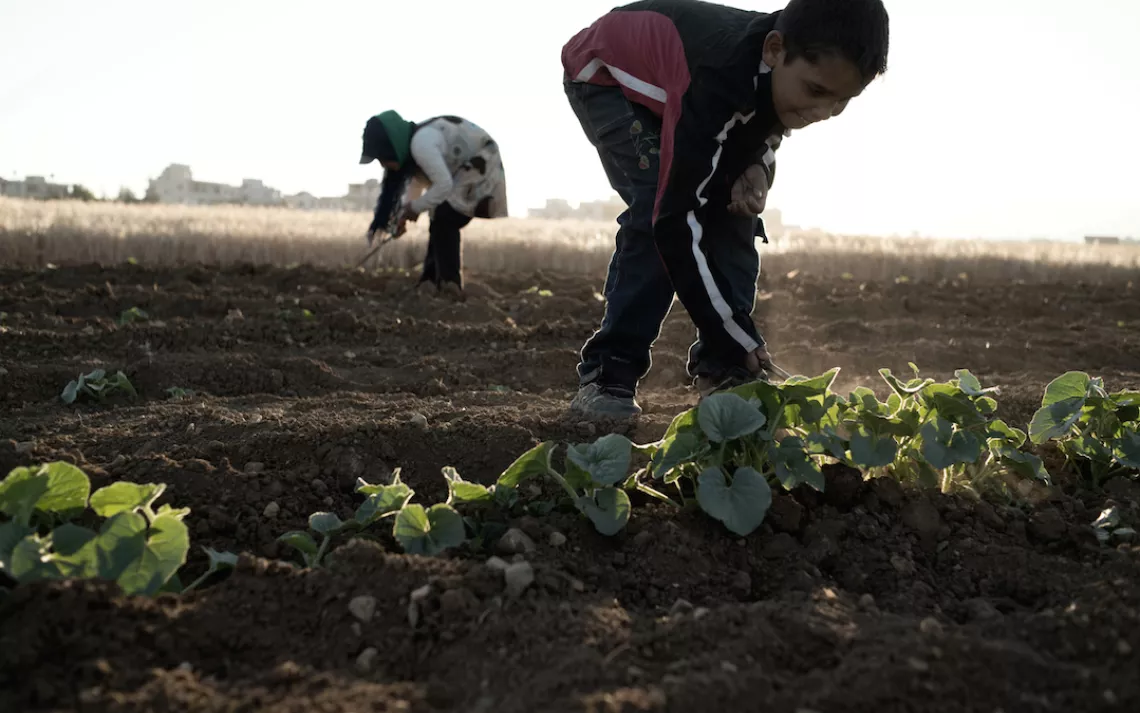This World Fair Trade Day, Think of the Children
Five facts about the ongoing child labor crisis

Syrian refugee Mohamad, 11, picks crops in a field in Lebanon's Bekaa Valley to support his family, instead of attending school. | Photo courtesy © UNICEF/ Romenzi/2016
Today marks World Fair Trade Day, a celebration of fair-trade supply chains, consumers, policy-makers, and advocates.
The sad truth is that child laborers are the least likely to enjoy fair-trade working conditions. According to the International Labour Organization (ILO), 168 million children toil worldwide. Almost half of them are forced to work in hazardous situations.
To be clear, a child tasked with chores such as making beds and setting tables does not constitute child labor. According to Article 32 of the United Nations Convention on the Rights of the Child—a legally binding international agreement since 1989—children have the right to protection from work that is harmful for their mental or physical health and/or education. The UN agreement also stipulates that children helping out on a family farm have the right to be safe and paid fairly, and that tasks must be appropriate to their level of development, and must comply with their country’s national labor laws. As outlined in Articles 28 and 31, labor should never interfere with a child’s right to play or rest.
Still, millions of individuals under 18 are exploited. To help put a more definitive end to child labor, UN member states in 2015 agreed to the Global Goals for Sustainable Development, which calls for immediate action to end all forced child labor by 2025.
Here are five facts every conscientious consumer should know about the ongoing global crisis.
1. Syrian refugees seeking asylum in North America are often escaping child labor.
According to the study “Because we struggle to survive,” released last year from the child relief agency Terre des Hommes, 50 percent of Syrian children do not attend school. The study also points to an increase in the economic exploitation of children in Syria and surrounding countries since 2014. Many of these children are forced to work in factories, in tents, in confined spaces, on farms, and even in the streets. Many Syrian boys are also recruited to war by terrorist organizations.
2. In West Africa, children are still forced to pick cocoa beans.
The Food Empowerment Project reports the western African countries of Ghana and the Ivory Coast provide more than 70 percent of the world’s cocoa, supplying major food conglomerates such as Nestle. While activists have long been aware of this issue, worldwide demand for cheap cocoa persists, and there’s been little progress in reducing child labor and slavery in West Africa. There, many children, faced with extreme poverty, start working at a young age to support their families. Some children forced to work on cocoa farms are only five years old and often don’t get paid at all. Many, according to the Food Empowerment Project, are “sold” to traffickers or farm owners by family members who are misled about conditions, while others are abducted from nearby African countries.
3. Haitian children are forced into domestic and agricultural labor.
Free the Slaves reports that despite the ban on slavery in Haiti, many children work for upward of 14 hours a day, without pay. The United States Department of Labor reported in 2015 that children in Haiti are forced into labor including domestic work, agriculture, and construction of materials such as sand and rocks. According to this report, Haitian children frequently become street vendors and beggars—and thus become more vulnerable to human trafficking. The agriculture industry in Haiti often uses children to prepare the land for planting crops and harvesting sugarcane. According to Fairtrade Canada, about 80 percent of the world’s sugar comes from plantations in developing countries—meaning that most likely, much of it is harvested by exploited minors.
4. Children miners in Zimbabwe are still entrapped in the slave trade.
The 2006 blockbuster Blood Diamond shed much-needed light on unethical diamond mines, and on the illicit diamond trade’s funding of the civil war in Sierra Leone. Yet despite this awareness, and although Zimbabwe has attempted to put an end to this (according to a report from Humanium: Together for Children’s Rights), 13 percent of children in Zimbabwe still end up employed in the diamond mines. Humanium also reports that some Zimbabwean children work in the farming sector, in cruel conditions, due to extreme poverty. Still others are recruited by traffickers to work domestically, and many become trapped in the slave trade. What’s more, UNICEF Zimbabwe reports that 15 percent of child laborers aged five to 14 years old are not in school.
5. Child labor has increased in Pakistan.
DAWN, Pakistan’s most widely read English newspaper, reported in 2016 that 12.5 million children in Pakistan were involved in labor—a four-fold increase since 1996. Despite a reduction in child labor worldwide, Pakistani children are increasingly forced to work in factories, car workshops, hotels, mines, and brick kilns, and in weaving, jewelry, construction, and agriculture industries. DAWN also reported that many children are forced to work inside lavish homes where they are treated inhumanely, and where, according to the Society for the Protection of the Rights of the Child, “cruel events” occur.
The good news is that awareness begets change—the trend has declined by 16 percent since 2000, when the ILO reported 200 million child laborers. So, keep on seeking fair-trade goods and demanding supply chain transparency from companies, and consider acting to expose child exploitation on June 12th, ILO World Day Against Child Labor. After all, silence does the human environment about as much good as it does the physical one.

(c)Tdh/Ollivier Girard; Courtesy of Terre des hommes
Save
Save
Save
Save
Save
 The Magazine of The Sierra Club
The Magazine of The Sierra Club



